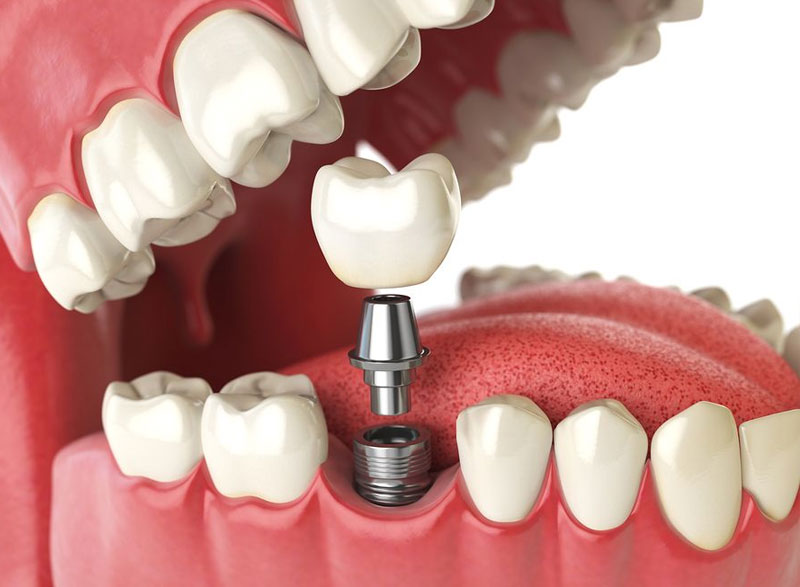Dental Implants in OKC, Stillwater, and Tulsa
Furthermore, dental implants are tremendously versatile and can be used to replace any number of missing teeth, even when the patient doesn’t have any remaining biological teeth.
When you are considering your options to replace missing teeth, be sure to explore the possibility of dental implants. Patients gain many advantages from choosing dental implants over conventional appliances to restore their smiles after tooth loss.
If you need to replace a missing tooth, schedule an evaluation at our office to learn more about dental implants and whether this might be the right choice for you.

How Dental Implants Work
Dental implants are small titanium rods that look similar to screws. The material used in dental implants is biocompatible, which means that it allows the bone tissue in the jaw to form a strong, permanent bond with the implant.
That process, called osseointegration, is completed over several months, and it results in the dental implant becoming a fixture in the patient’s jaw. Essentially, the dental implant can serve as an artificial tooth root, supporting the crown and performing other important functions.
The Dental Implant Treatment Process
Dental implants require a surgical procedure for placement. The oral surgeon makes a small incision in the jaw and creates space in the jaw to insert the implant. The surgical site is then stitched back up, and osseointegration will proceed.
The dental implant must be inserted in a precise location, and we rely on numerous types of technology to help us locate the implant in exactly the right spot. Any of the following tools may be used in treatment planning or placing the dental implants:
CAD software
Computer-assisted design software that can be used to create a detailed plan for dental implant placement as well as assist with the design of the restoration.
Cone Beam Computed Tomography (CBCT)
Provides three-dimensional images of the jaw that offer a realistic representation of the surgical site.
X-guide
Three-dimensional navigation machine that combines images from various sources into a detailed interactive guide that improves dental implant placement accuracy in terms of depth and angle.
Because we have access to all of these different types of technology, we can perform dental implant placement with predictable results.
Technology also plays a role in designing the restoration supported by the dental implant. We use 3-D printers to create a temporary restoration for you to wear while we collaborate with your dentist on the design of your permanent crown, bridge or denture.
Dental Implants Useful In Various Tooth Loss Scenarios
After they are placed and fully osseointegrated, dental implants can support any type of dental restoration, including single crowns, dental bridges, and dentures. Therefore, a patient can replace any number of missing teeth using this treatment method.
However, patients must be suitable candidates for dental implant placement. The primary concern is the availability of bone tissue to support osseointegration. Bone loss can create an obstacle to dental implant placement. Patients with this issue might need a bone graft at the site.
Advantages Of Replacing The Entire Tooth Structure
Why should patients choose dental implants over conventional restorations? There are many compelling reasons, such as:
- Dental implants are more stable over time than standard appliances because they prevent jawbone atrophy while securing the restoration.
- Dental implants stand alone, so surrounding teeth don’t have to be compromised by placing crowns on them to support an artificial tooth.
- Dental implants are more effective at holding a denture in place than denture adhesives.
- Dental implants preserve nearly all of the chewing function of the biological tooth or teeth, so the patient can continue to enjoy nutritious foods like fresh fruits and vegetables.
These are just a few of the benefits associated with dental implants. Ask your oral surgeon about others that may be important for you.
Common Dental Implants Questions:
What is a dental implant?
A dental implant is a small titanium cylinder that looks similar to a screw. After it is placed in the jaw, the bone fuses with the implant and it becomes a permanent fixture in the jaw. A dental implant serves as an artificial tooth root that can secure a crown, bridge or denture.
How much do dental implants cost?
The cost of dental implants will vary from patient to patient. It may also reflect auxiliary services such as imaging, bone grafting (when necessary) and follow-up care. We can give you a more precise idea of your estimated costs after evaluating your case.
Am I a candidate for dental implants?
Bone quality is the primary qualification that determines whether a patient is a good candidate for dental implants. When assessing your case, we will look for signs of bone loss that could present an obstacle to osseointegration. At your evaluation, we can tell you if you are a good candidate for this treatment.
How are dental implants placed?
Dental implants are placed in an outpatient procedure that is completed in just a few hours. The oral surgeon makes an incision in the patient’s gum tissue, inserts the dental implant at the identified site and then stitches the incision back together. A local anesthetic is administered at the implant site, and patients also can choose sedation or general anesthesia for optimal comfort.
